Message Thread:
Crown on vaulted ceilings
12/30/13

In the somewhat near future, I will be attempting to do crown on vaulted ceilings, but what throws a wrench into this is that the home in Arizonia had 3/4" bullnose radiused corners. I saw a tool on I believe on either Rockler or Woodcrafts web site that draws a horizontal line around a bullnose on a horizontial plane.
Has anyone ever do crown on a vaulted ceiling with bullnose corners?
How much more challanging is it than the already difficulty associated with crown on a vault with square corners?
Any tips/tricks?
Thx!
12/30/13 #2: Crown on vaulted ceilings ...

A laser level easily puts a line on your radius corners. Or, bore a proper sized hole in a block of wood, slice it in half and use that as a guide to pencil a line around your radius.
We run our moldings the same as with square corners, then insert (with glue) small "radius fillers" into the open corner showing on the bottom of the crown. We cut these out on a scroll saw, or, if they are a very consistent radius, we'll use a forstner drill bit to bore out the correct size in a blank piece of wood. We then cut two "fillers" out of each bored piece which yields a perfect radius.
Not really any more difficult, other than a bit more time consumed making, finishing and inserting the fillers after the crown is installed. Looks very professional, clients are always quite pleased with the results. I'll have to see if I can dig up a photo or two - no promises though.
12/30/13 #3: Crown on vaulted ceilings ...

Crown molding, as it is commonly known, will not make the transition from a level run to a pitched or 'cathedral' ceiling and maintain its width or vertical height.
The pitched molding must be substantially wider in order to mate to the level molding. The greater the pitch, the greater the width differential.
This is not a matter of skill or chop saws, but is due to simple physics. Take two 3' long pieces of any crown molding and mock it up. You will see in a moment.
Developed moldings (ones that change width as they pitch) have been made for centuries, but this solution is beyond the average carpenter.
Makes the bullnose a moot question, tho much more simple to solve.
12/30/13 #4: Crown on vaulted ceilings ...

Thank you for the input. Please correct me if im wrong here, but I remember reading in a crown molding book, where it teaches you how to cut a transition piece, lets call it a triangular piece, that will allow you to transition from a horizontal plane to a vaulted plane. Would the same rules not apply and as far as getting the crown around the bullnose, my first thought is that it would be 30/60/90
12/30/13 #5: Crown on vaulted ceilings ...

David, the point you are making has been broached many times here in the past.
Most commonly used today is a "pie-shaped" transition piece that enables the use of similar sized horizontal runs to mate up with the slanted pitched runs. No need to utilize "developed" moldings. This transition piece is totally acceptable by current standards and is quite common with todays vaulted ceilings.
But to stay on topic, that is not the direction of discussion posed by Mike (the OP). His question was how to address the radius corners. Telling him this is a moot point is probably not the response he's looking for...
12/30/13 #6: Crown on vaulted ceilings ...

Thank you ML. You're right, i'm looking for possible solutions unless im already on the right track
12/30/13 #7: Crown on vaulted ceilings ...
 Website: http://www.handrailer.com
Website: http://www.handrailer.com
To stay on the topic it's also possible to order radius crown molding corners just like base molding pieces.
Jumping off the topic, it's usually an architectural mistake and amateur approach to continue crown moldings up the rake angle of a vaulted ceiling.
12/31/13 #8: Crown on vaulted ceilings ...
 Website: http://www.mirror-reflections.com
Website: http://www.mirror-reflections.com
Here is and Example of what Dave is explaining, the angle's change depending on the rise and run. These are the same profile but the vaulted one has the vaulted ceiling in mind.
Happy New Year everyone!
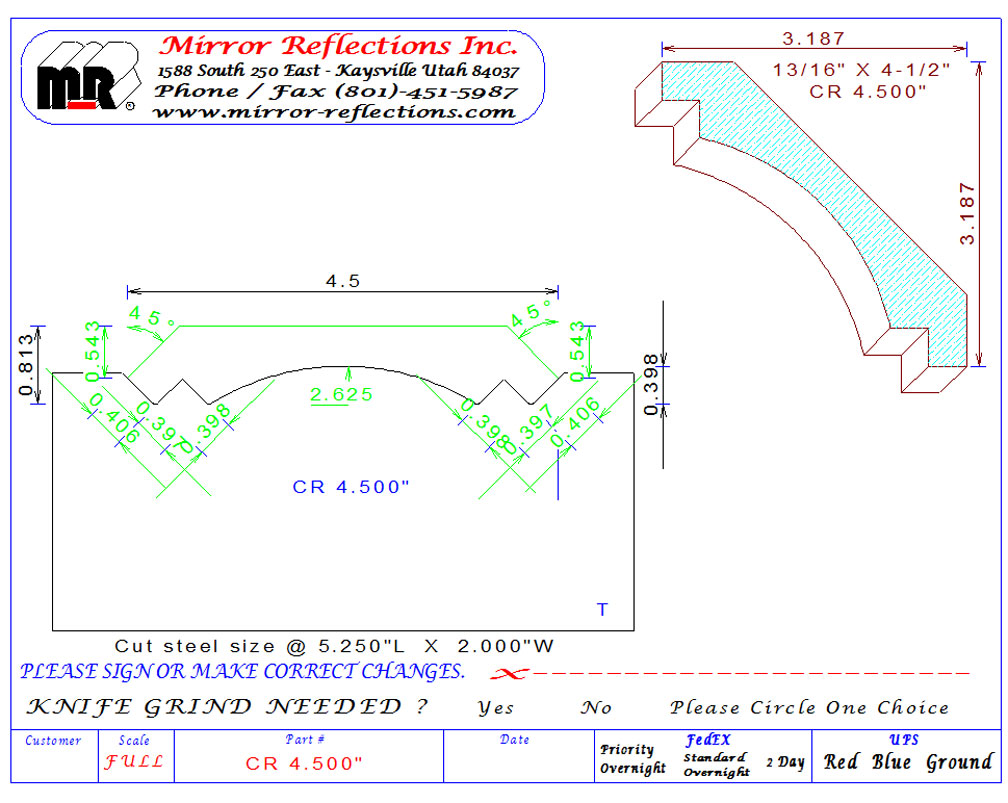
View higher quality, full size image (1008 X 803)
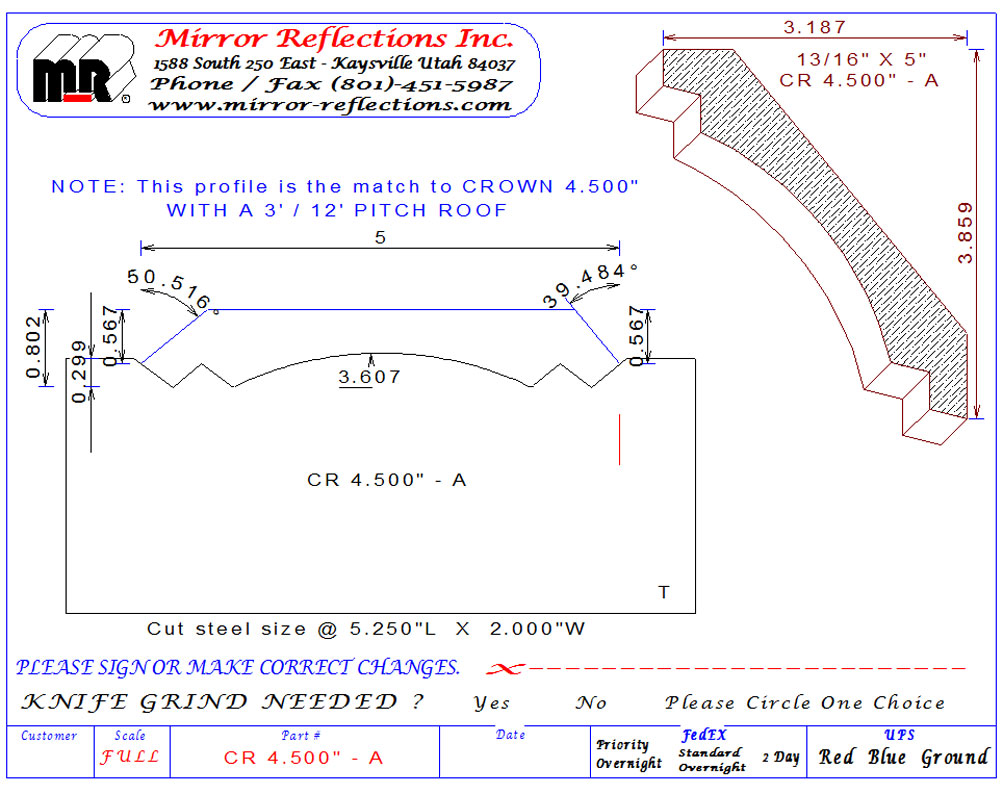
View higher quality, full size image (1003 X 794)
12/31/13 #9: Crown on vaulted ceilings ...
 Website: http://www.mirror-reflections.com
Website: http://www.mirror-reflections.com
The second drawing should say 3" / 12" instead of feet like shown. How we did it was figure the angle first then transpose the shape with the new angles lines, lots of work, a brain teaser for sure. I have only done this a couple of times but it works.
12/31/13 #10: Crown on vaulted ceilings ...
 Website: http://www.josephzambarano.com
Website: http://www.josephzambarano.com
Mike,
I have done this on many occasions and its not an amateur approach to run crown up the rake. It actually take a great deal more skill to pull it off and more time. As far as turning the radius I will make the corner out of three pieces. The first two are the straight runs with a 22.5* angle and the middle piece is a small piece with 22.5* angles on either side. This piece will be smaller at the bottom and will be right on the radius. I will try to post some pictures of some I did in my house. The thing to keep in mind is that all the crown has to stay at the same angle off the wall. This means that it may be necessary to put a bevel on the back side of the top of the crown to allow it to hit the ceiling at the same point on the exposed side of the face. The transitional piece in the corner will be triangular with a 45* on one side and a compound angle on the other. The trick is to find that angle... every profile of crown will have a different compound miter needed to make the crown look correct so be sure to do your test pieces out of the same crown you will be installing. Mine was like a 9* degree with a 3* back bevel. Just remember that will take time so just be patient. I hope this helps and post some pictures so we can see your success. God Bless and good luck!
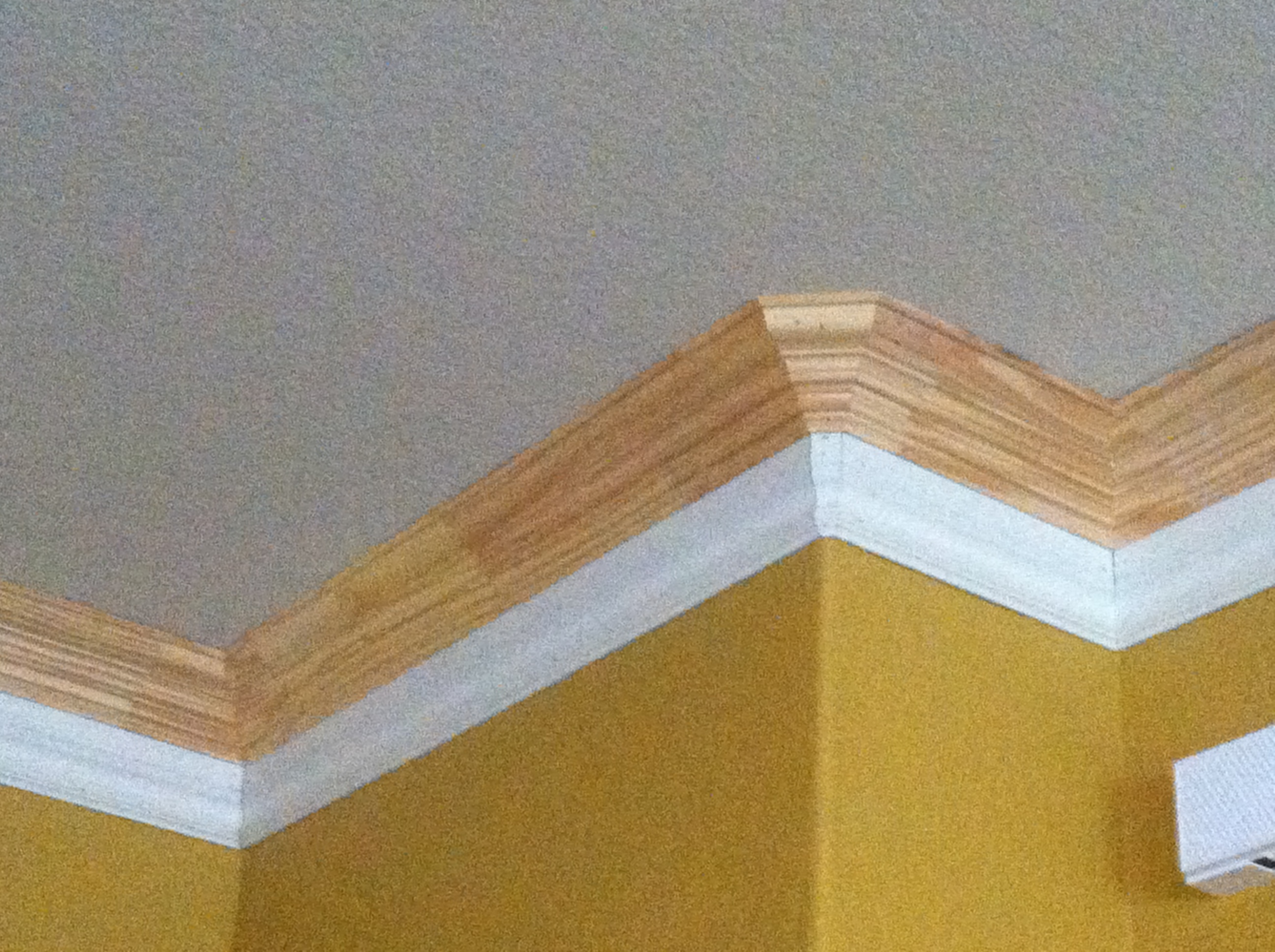
View higher quality, full size image (2592 X 1936)
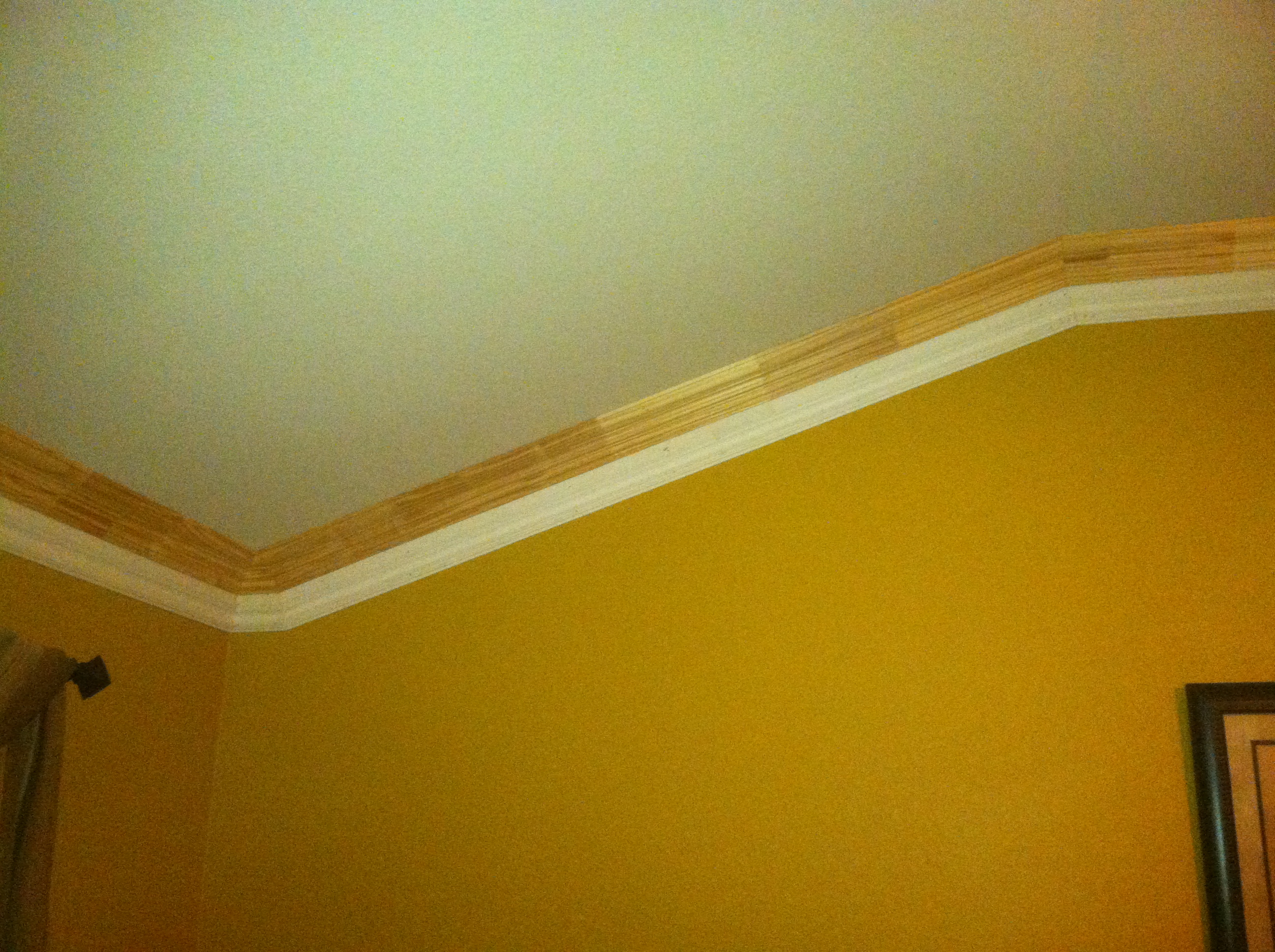
View higher quality, full size image (2592 X 1936)
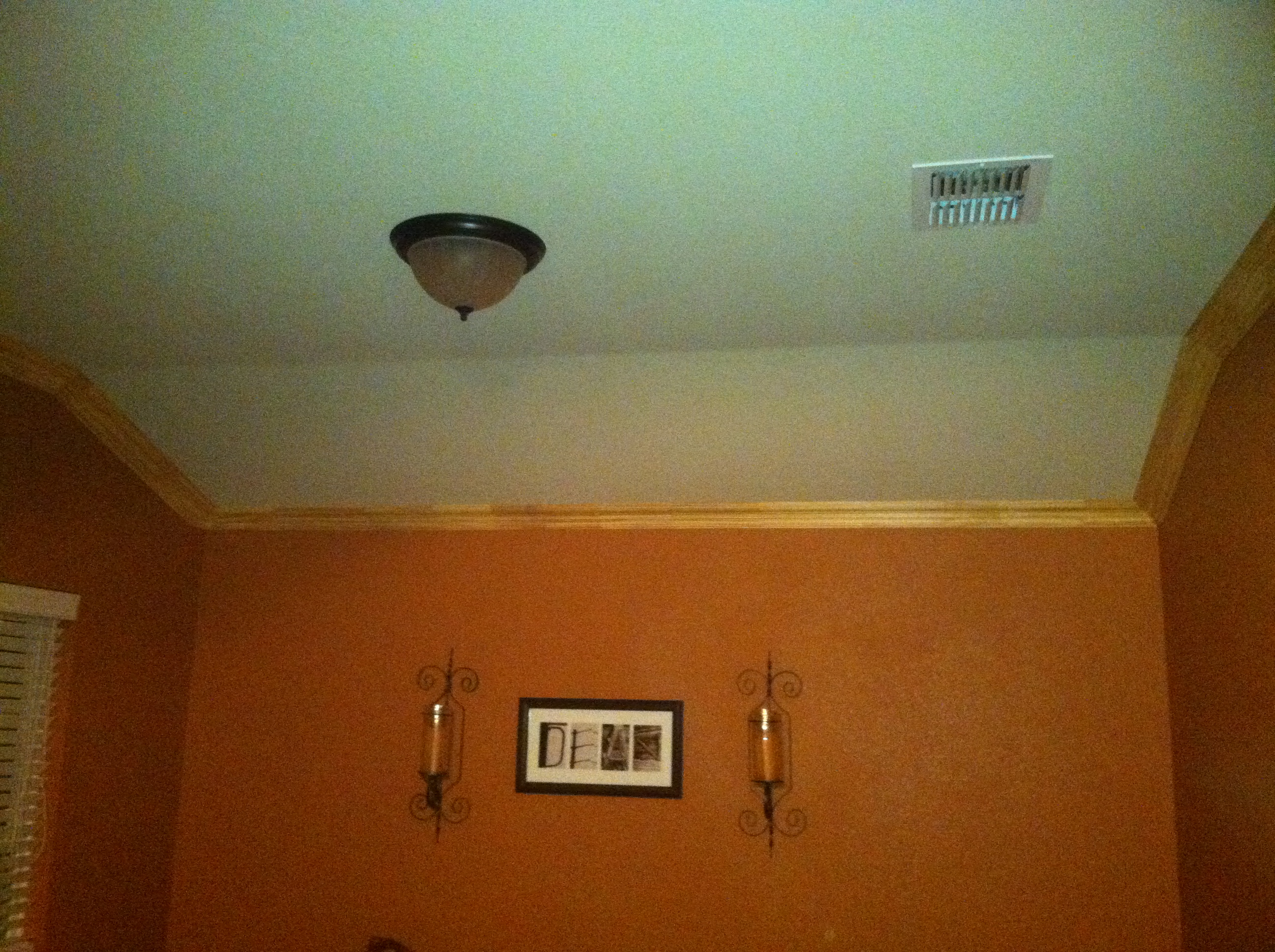
View higher quality, full size image (2592 X 1936)
12/31/13 #11: Crown on vaulted ceilings ...
 Website: http://www.handrailer.com
Website: http://www.handrailer.com
In classical arcitecture, crown molding is a component part of the level cornice detail and not a convenient corner batten. The raked ceiling and gable ends form the upper pediment. The fact that it's possible to cut interconnecting pieces while altering installation angles, is usually evidence of a lack of understanding of proper composition of molding elements.
Crown molding is best when installed at it's proper angle and in support of a horizontal member which runs the perimeter of the room (and without regard to raked ceilings).
Crown molding is not facia board.
12/31/13 #12: Crown on vaulted ceilings ...

Jim - you seem really against this practice. If your client requests installation of same (despite your probable dissuasion) do you stand on your principle and walk? And in doing so by default gifting one of your competitors a (usually very profitable) project, given the higher cost of a more complex installation.
I'm amused at how you say this is an amateurish mistake, yet I sincerely doubt an amateur woodworker could successfully (spelled professionally) complete a project of this complexity.
With that said, I do agree with you as I also feel that crown should only be applied in horizontal planes, and not following the rake of a vaulted ceiling. But, after explaining my reasoning to a client - should he still wish to proceed with this unorthodox installation, and is compliant with my (quite liberal quote) for performing this task - I'm first one up the ladder... :-)
And also first to apologize to Mike (the OP) for the tangent course we've taken here from his original request. For after all - this tangent is a moot point given he apparently already has contracted the job and is now merely asking assistance on how to treat the radius.
12/31/13 #14: Crown on vaulted ceilings ...
 Website: http://www.handrailer.com
Website: http://www.handrailer.com
ML, honestly I'm not nearly as snobbish or impractical as I may sound and of course I'll do whatever the customer wants. I also believe though, that we can be more than just guys with nail guns. Instead of spending more time and money doing something questionable, why not up-sell the whole project by offering architecturally correct details? As I've said before, crown is just part of a full cornice detail and just part of a more complete-makeover including casement of doors, windows and base. Either way though, finish carpenters should have a basic understanding of classic architecture and elements of molding.
I'm suggesting then that we sell ourselves first , with our best foot forward and from a position of knowledge based on homework rather than "monkey-see.". Indeed that's the whole point of participation on Woodweb no matter how far off the topic we may roam.
12/31/13 #15: Crown on vaulted ceilings ...

I agree with Jim on all counts.
It is not Jim that is really against the practice, it simply is not good design. It indicates there is a low level of knowledge of design and that whomever is making the request knows little more than 'crown is good' about the subject.
Do we have an obligation to try to find solutions that exist within the confines of good design? Should someone in the process speak up? Look at a book?
While crown can be run up a rake using either of two methods described above ( I admit the pie shape solution is a new one to me - I need to get out more!), good architectural practice and design dictates that it not be done. If one knows a bit about Classical architecture and where our familiar things originated, the solutions would be moot.
In current consumer markets, a designer and/or good taste is viewed as being snobbish and certainly a waste of time and money. I have seen many a multi-million dollar project ruined by a homeowner that says "we don't need a designer, I'm going to do it all..." When complete, they will ask me me what I think. The standard response is "I don't know what to say..." And I don't.
I guess it comes down to what you want or need to do, and whether your own personal taste would enter into the discussion. I know that most of my customers trust me to do my best at proper design, with historical perspective and a reason for why things look the way they do. It is just not a free for all. Certainly not for me, and it should not be for them.
But this is all just opinion.
12/31/13 #16: Crown on vaulted ceilings ...

I must say... It ceases to amaze me how my original, thought to be somewhat of a simple question, could be turned into a battle of wits on whether the design aspect of doing what I would like to learn how to do on a friends home, is the right thing to do.
I say who cares! I just want to know what others have done in my situation, regardless of whether you think it's a key appropriate design element.
Now, moving forward..... Please constructively answer my question for what it is and leave out the battle of wits.
Thank you!
1/1/14 #17: Crown on vaulted ceilings ...
 Website: http://www.handrailer.com
Website: http://www.handrailer.com
Mike, your simple question with regard to the radius corners has already been adequately and constructively answered with three suggestions...square corners with filler-pieces, clipped corners or quarter-round crown segments. Most of us here however have the wits and experience to recognize that the bullnose corners are the least of your problems. The real challenge is the transition from level to rake which is something you don't seem to grasp. As for myself, I apologize for caring about something which you obviously couldn't car less about and for wasting your time and mine. I should hope though that you care more for your friends than you do for your profession but at this point who cares?
1/1/14 #18: Crown on vaulted ceilings ...

Mike - I will apologize also, but keep in mind that when I posted, I had no idea of who you are, your level of proficiency or experience, much less education or goals for your chosen field.
I answered with the developed solution since I am familiar with it, intrigued by it, and have spent 40 years explaining to carpenters why crown doesn't like to go up a rake. I thought the bullnose question so simple as to hardly warrant attention.
Russ's contribution to the solution of developed moldings is one of the few I have seen where the technique is even mentioned, much less understood. Where else but here can the knowledge he willingly shares find a home? To someone searching out this topic a month or a year from now, his post is invaluable. I have struggled to explain developed moldings to architects and designers that simplethink it is only a matter of setting the miter box correctly, and that I am somewhere the other side of overcomplicated.
I often learn far more on Woodweb from the evolved conversation between two or more professionals than I do from a direct simple answer. Yes, I like to think I know all those simple answers, but as I mentioned earlier, I still learn everyday (triangular wedge to transition the crown).
This is not a battle of wits, but an open sharing of knowledge, give and take, point and counterpoint that all add to the subject at hand. You may not need or want to know this today, but the day may come where you wish you had this info. It is a sad day when bright people sharing information is regarded as nonconstructive. Who cares!?
Ours is a very fragmented and disorganized profession - lots of different people doing lots of things, lots of different ways. I think it helps to know as much about all these different ways as possible so as to have another solution or two in your pocket should the one you have not work.....
But this is just all opinion.
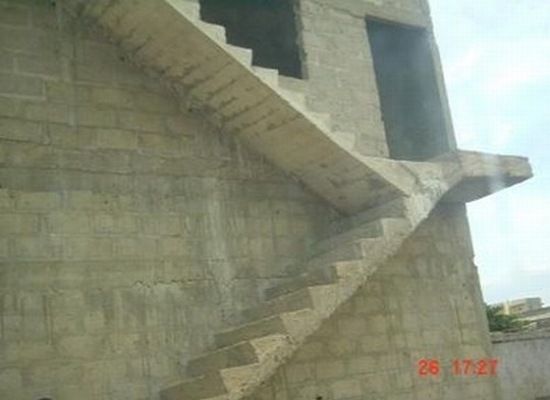
View higher quality, full size image (550 X 400)
|
